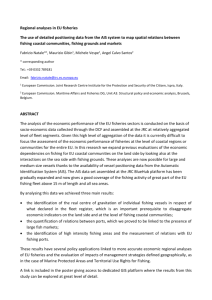A BIO-ECONOMIC SIMULATION MODEL FOR THE ITALIAN FISHERIES
advertisement
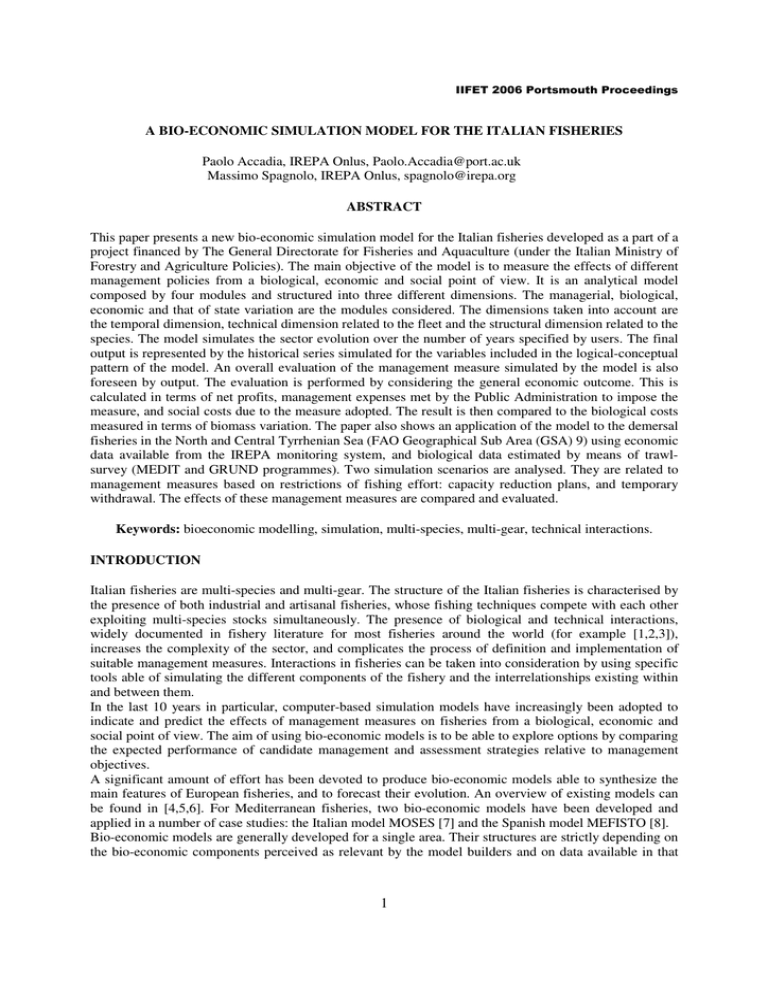
A BIO-ECONOMIC SIMULATION MODEL FOR THE ITALIAN FISHERIES Paolo Accadia, IREPA Onlus, Paolo.Accadia@port.ac.uk Massimo Spagnolo, IREPA Onlus, spagnolo@irepa.org ABSTRACT This paper presents a new bio-economic simulation model for the Italian fisheries developed as a part of a project financed by The General Directorate for Fisheries and Aquaculture (under the Italian Ministry of Forestry and Agriculture Policies). The main objective of the model is to measure the effects of different management policies from a biological, economic and social point of view. It is an analytical model composed by four modules and structured into three different dimensions. The managerial, biological, economic and that of state variation are the modules considered. The dimensions taken into account are the temporal dimension, technical dimension related to the fleet and the structural dimension related to the species. The model simulates the sector evolution over the number of years specified by users. The final output is represented by the historical series simulated for the variables included in the logical-conceptual pattern of the model. An overall evaluation of the management measure simulated by the model is also foreseen by output. The evaluation is performed by considering the general economic outcome. This is calculated in terms of net profits, management expenses met by the Public Administration to impose the measure, and social costs due to the measure adopted. The result is then compared to the biological costs measured in terms of biomass variation. The paper also shows an application of the model to the demersal fisheries in the North and Central Tyrrhenian Sea (FAO Geographical Sub Area (GSA) 9) using economic data available from the IREPA monitoring system, and biological data estimated by means of trawlsurvey (MEDIT and GRUND programmes). Two simulation scenarios are analysed. They are related to management measures based on restrictions of fishing effort: capacity reduction plans, and temporary withdrawal. The effects of these management measures are compared and evaluated. Keywords: bioeconomic modelling, simulation, multi-species, multi-gear, technical interactions. INTRODUCTION Italian fisheries are multi-species and multi-gear. The structure of the Italian fisheries is characterised by the presence of both industrial and artisanal fisheries, whose fishing techniques compete with each other exploiting multi-species stocks simultaneously. The presence of biological and technical interactions, widely documented in fishery literature for most fisheries around the world (for example [1,2,3]), increases the complexity of the sector, and complicates the process of definition and implementation of suitable management measures. Interactions in fisheries can be taken into consideration by using specific tools able of simulating the different components of the fishery and the interrelationships existing within and between them. In the last 10 years in particular, computer-based simulation models have increasingly been adopted to indicate and predict the effects of management measures on fisheries from a biological, economic and social point of view. The aim of using bio-economic models is to be able to explore options by comparing the expected performance of candidate management and assessment strategies relative to management objectives. A significant amount of effort has been devoted to produce bio-economic models able to synthesize the main features of European fisheries, and to forecast their evolution. An overview of existing models can be found in [4,5,6]. For Mediterranean fisheries, two bio-economic models have been developed and applied in a number of case studies: the Italian model MOSES [7] and the Spanish model MEFISTO [8]. Bio-economic models are generally developed for a single area. Their structures are strictly depending on the bio-economic components perceived as relevant by the model builders and on data available in that 1 area. Therefore, exporting a bio-economic model in another geographical area and applying it within a different economic and biological contest may not be an appropriate approach. MOSES was for many years the only model specifically designed for the Italian fisheries. It is a static equilibrium model and was conceived as an optimization model aimed at estimating the long-term effects of changes in fishing effort. The need for simulating not only long-term effects of management measures but also short-term transition situations in the Italian fisheries resulted in the development of a new simulation model, called BIRDMOD. This model has been developed for a project financed by the Italian Ministry for Agriculture and Forestry Policy and carried out by IREPA (Institute for Economic Research on Fishery and Aquaculture) and SIBM (Society of Marine Biology). This paper aims to present the main components of the BIRDMOD model and an application of the model to simulate management measures based on restrictions of fishing effort for the demersal fisheries in the North and Central Tyrrhenian Sea (FAO Geographical Sub Area (GSA) 9). BIRDMOD MODEL BIRDMOD is a bio-economic simulation model applied to the fishing sector. The model is multi-species and multi-gears. Taking into account a number of species, fleet segments and fishing gears, and the technical interactions among them, this model is directed at reproducing the bio-economic structure of demersal fishery within the Mediterranean area. The aim of the BIRDMOD model is to simulate the effects of the main management measures on the sector. These are mainly restrictions on the fishing effort in terms of activity and capacity, but also technical and economic measures, such as variations in gear selectivity and introduction of taxes and subsidies. The simulations are conducted step-by-step at regular time intervals along the period defined by the user for prediction. In this sense, BIRDMOD is a dynamic model. The final output is composed of the historical series simulated for the biological and economic variables included in the logical-conceptual pattern of the model. An overall evaluation of the management measure simulated by the model is also foreseen by output. The evaluation is performed by considering the general economic outcome. This is calculated in terms of net profits, management expenses met by the Public Administration to impose the measure, and social costs due to the measure adopted. The social costs are considered exclusively in terms of variation in the number of workers employed in the sector. The result is then compared to the biological costs measured in terms of biomass variation. The BIRDMOD model is arranged into the following four main modules: • Biological module; • Economic module; • Management module; • State variation module. The biological module simulates the evolution of the state of the biomass among the stocks exploited by the fishing activity. The economic module simulates the evolution of the state of the fleet within the geographic area of interest. The management module enables us to reproduce the Public Administration’s intervention on the sector and to measure the effects of the different management policies. The state variation module permits to draw the dynamic relations between the overall variables of the model by means of predetermined behaviour rules. The model structure, arranged into two levels, is shown in Fig. 1. The level marked in green, which consists of the biological and economic boxes and the state variations, represents the natural trend of the sector. The biological component affects the economic outcome of the model and this determines a series of variations in the operators’ choices which, in turn, influence the state of the system and the biological component. The central level, marked in red, represents the management activity affecting both the biological and the economic components which may also influence the operators’ decisions included in the state variation box. The different management tools pertaining to the Public Administration are the main component of this process. 2 Figure 1. BIRDMOD model structure. BIOLOGICAL SUB-MODEL The biological component of the model is aimed at calculating the yield for a given level of effort. Two types of production-effort relationships are considered: age-structured model [9,10] and global model [11]. The age-structured model, being more detailed, is more reliable in describing and simulating the evolution of the state of biomass among the species. It is able to produce catches for each species and length class, plus a number of biological indicators useful to evaluate the state of the stocks. This approach results particularly useful also in simulating the effects of specific management measures based on variations in gear selectivity, which is not possible by using global models. Nevertheless, the data required to assess the stock by an age-structured model are generally very intensive, and are not available for each species. The most relevant aspects of the BIRDMOD age-structured model can be summarised into the following two points: • It is organized in time intervals equal to a month to allow the discreteness of population and catches in line with management measures possibly based on monthly adjustments (e.g. temporary withdrawal from fishing activities). • Catch and effort (expressed in terms of fishing days) are organized by fishing gears. From 1 to 4 different fishing gears can be simultaneously included in a single simulation. The problem to measure the catches for the group of species not handling by an age-structured model is very common in multi-species fishery bio-economic modelling, and has been tackled in a number of papers. In [1], to develop a simulation bioeconomic model for English Channel fisheries, four types of catch-effort relationships were defined, depending on available data. In [8], to develop a simulation bioeconomic model for Mediterranean fisheries, the catches of “secondary species”, whose dynamic is not totally known, are calculated in relation to those of the “main species”, whose dynamic is known and consequently assessed by an age-structured model. In the BIRDMOD model, this problem has been approached by estimating these catches by a “modified” Schaefer model. The Schaefer surplus production model is an equilibrium model, which provides an indication of the long term level of catch for a given level of fishing effort. The use of an equilibrium model into a dynamic model, as the BIRDMOD model, has been made possible by adopting some arrangements. The Schaefer equation has been modified to take into account also the short term effects deriving from a variation in the effort level. Many attempts to transform the classical surplus production models [11,12] from equilibrium models to dynamic models can be found in literature [13,14,15]. They were aimed at estimating the equilibrium 3 curves parameters from non equilibrium fisheries data. The approach proposed by Lleonart and Salat was adopted in [16] to develop an optimization bioeconomic model, called MOSES. This approach was based on an additive relationship between long and short term equations. Catches in the t-th year were expressed as a weighted sum of an equilibrium term (Schaefer equation) and a short period term, obtained by assuming constant CPUE: C t = S (k 0 Et − k1 Et2 ) + (1 − S )C t −1 ( Et Et −1 ) , (Eq. 1) where C represents the catches, E is the effort, k0 e k1 are the parameters of the Schaefer equation, and S is a coefficient which makes possible to consider all the situations ranging between a purely steady state model with fast response time (S = 1) and a constant CPUE model with equilibrium conditions reachable only at infinite time (S =1). In the BIRDMOD model, a multiplicative relationship between long and short term equations, suggested by empirical evidence on the data fitting, was preferred to the additive relationship reported above. So, the catch-effort relationship used in the BIRDMOD model to simulate the catches of the species not handling by an age-structured model can be formulated as follows: C t = (k 0 E t − k1 E t2 )( E t E t −1 ) , (Eq. 2) where Ct are the total catches resulting from all the fleet segments considered, Et is the equivalent fishing effort expressed as aggregate days at sea, and k0 e k1 are parameters of the long-term component. The first part of the formula expresses the long-term effect according to the Schaefer model. In order to consider the short-term effect, the estimate of the long-term catches is rectified multiplying it by the per cent variation over the aggregate fishing days from the time t-1 to the time t. Estimating the equivalent effort is justified by the need to consider the different productivity of the fishing effort units by fleet segments. To this end, a process of “effort standardization” has been developed following an approach similar to that by [10] for the “catch rate standardization”. A “standard” fleet segment s was selected and the relative productivity of all other fleet segments i determined at each time t by RPi ,t = C i ,t E i ,t C s ,t E s ,t , (Eq. 3) where RPi is the relative productivity for fleet segment i, Ci the total catch by fleet segment i, CS the total catch by the standard fleet segment, Ei the total effort by fleet segment i, and ES the total effort by the standard fleet segment. The equivalent effort at time t is then obtained using the weighed sum of the total effort per fleet segment, where the weights are the relative productivity factors: E eq ,t = i RPi ,t Ei ,t . (Eq. 4) ECONOMIC SUB-MODEL The economic component of the model is aimed at calculating the profits deriving from the fishing activity. The output of this module is then represented by the level of profits, obtained by revenues minus costs; while the main inputs are landings, calculated by the biological box, and fishing effort. The economic component transforms landings into revenues by multiplying them by prices, and fishing effort into costs. Fishing effort is here expressed both in terms of activity (fishing days), as in the biological box, and capacity (gross registered tonnage (GRT)). 4 The BIRDMOD economic box is formulated by fleet segments and constant time intervals equal to a year. The main elements of the economic box are prices and costs functions. Prices function In the BIRDMOD model, prices are broken down by species or group of species and by fleet segment. It is also possible to consider a price differentiation by commercial category, in which these categories are associated to the length classes of a single species. This price differentiation is feasible only with the species for which a biological model structured into length classes is foreseen (age-structured model). Generally speaking, price dynamics can follow two different hypotheses. In the former case, the prices by fleet segment (and possibly by commercial category) are assumed as constant and equal to the prices registered over the base year: p s , f ,t = p s , f . (Eq. 5) In the latter case, the prices are assumed as a function of the quantity produced, that is, the catches. The functional relation between prices and catches is defined using a flexibility coefficient per each species and fleet segment. The flexibility between prices and catches is considered as the per cent variation in prices due to the unitary per cent variation in the catches: p s , f ,t = p s , f ,t −1 1 + α s , f C s , f ,t − C s , f ,t −1 C s , f ,t −1 , (Eq. 6) where α s, f is the flexibility coefficient per a given species and fleet segment. The model enables us to classify prices into commercial categories. These prices are estimated by the model on the basis of the following series of inputs requested to the user: • Number of commercial categories by species; • First length class by category; • Relation between the prices of each commercial category and the price of the last (the lesser value) category. The price estimate by each commercial category is performed using a system of simultaneous equations subject to the restrictions on the relations between prices introduced by the user (Eq. 8-10). The other limitation (Eq. 7) constraints the species average price, given the quantities simulated per commercial category by the biological box, to be equal to the real price registered in the base year. Thus, a system of equations for a four commercial categories classification can be formulated as follows: C s1 p s1 + C s 2 p s 2 + C s 3 p s 3 + C s 4 p s 4 = C * p p s1 + ps2 + C = C s1 + C s 2 + C s 3 + C s 4 (Eq. 7) − a1 p s 4 = 0 a1 = p s1 p s 4 (Eq. 8) − a2 p s 4 = 0 a2 = ps 2 ps 4 (Eq. 9) a3 = p s 3 p s 4 , (Eq. 10) p s 3 − a3 p s 4 = 0 where C represents the catches of the species considered and performed using a specific fleet segment, Csi the catches of a specific set of length classes or a specific (i-th) commercial category, psi the price for the i-th commercial category to be estimated, p the average price registered for the whole species, and the a coefficients the ratios between the prices psi provided by the user. 5 Cost function The costs, which are subtracted from the revenues to obtain the added value and the profits, are divided into the following groups: • Variable costs; • Fixed costs; • Labour costs; • Interests and amortizations. On the basis of the structure of the economic account adopted, variable costs are subdivided into three headings: cost of fuel and lubricant, commercial and others variable costs. They are a function of the effort (GRT multiplied by average days at sea) as to the components related to fuel and lubricant, and other variable costs; while the component of the commercial costs is a function of the level of catches. Fixed costs, instead, are a function of the GRT, both as regards maintenance expenses and other fixed costs. The labour cost is calculated as a quota equal to 50% of the difference between revenues and variable costs. This statement is justified by the prevalence of the share contract over other payment systems adopted by the Italian Regulations governing the fishery sector. Gross profit is then obtained from the difference between revenues and intermediate costs (the sum of variable and fixed costs, and the labour cost). Finally, to obtain net profit, amortizations and interests are subtracted from gross profit. Amortizations and interests are estimated as a function of the GRT of the fleet segment. Net profit represents the main output of the economic box. Estimated based on the catches, prices and costs, net profits are further adjusted by taking into account the effect of management policies, defined in terms of taxes and subsidies. Each group of costs considered by the model in the economic box is estimated by using a direct proportional relationship with the related independent variable. Then ratios between dependent and independent variables are kept constant throughout the years of simulation. DISTRIBUTION MATRIX The biological and the economic boxes show different structures both with the temporal dimension of the simulation and the structure of the input data. The simulation of the biological box works on the basis of monthly intervals, whilst the economic box shows a yearly dynamic. This distinction is justified by the different features of the two sub-systems. Indeed, the biological aspects of the system are linked to the seasonal nature of natural phenomena. The life-cycle of the species exploited, the reproduction periods and the weather conditions affecting fishing mortality must all be taken into account and need to be arranged into time intervals lower than a year. On the other hand, the economic variables are hardly discernible on the basis of monthly intervals. In particular, the costs of the fishing activity can barely be subdivided into single months unless applying specific estimates. Besides, the decisions made by the operators concerning the investments are usually based on the economic outcome of the preceding year. As for the structures, data in the biological box are organized by fishing gear and species. On the contrary, within the economic box the aggregation of the vessels is defined by fleet segment, where a fleet segment usually makes use of different fishing gears. Fleet segments are generally defined as a function of the main gear used, but it is possible that in some periods of the year the main gear is supported by others. Besides, some fleets, such as the “small-scale” and the “polyvalent”, fisheries are characterized by the use of different gears, which, in some cases, work simultaneously. Within the model, the differences between the biological and the economic boxes have been managed using a series of matrixes that allow converting catches and fishing days per fleet into catches and fishing days per gear, and vice versa. In particular, for each month and species, the catches per gear are obtained by a linear combination of catches per fleet according to a series of coefficients which identify the 6 percentages of catch distribution per fleet among the different gears. This equation system can easily be represented with the following matrix, which considers four fleet segments and four fishing gears: c f 1, g1 c f 1, g 2 c f 1, g 3 c f 1, g 4 [C f1 Cf2 Cf3 Cf4 ] c f 2, g1 c f 2, g 2 c f 2, g 3 c f 2, g 4 c f 3, g 1 c f 3, g 2 c f 3, g 3 c f 3, g 4 [ ] = C g1 C g 2 C g 3 C g 4 , (Eq. 11) c f 4, g1 c f 4, g 2 c f 4, g 3 c f 4, g 4 which can be more concisely expressed as follows: C f * D f ,g = C g , (Eq. 12) where Cs represents the vector of catches by fleet segment, Ca is the vector of catches by gear and Ds,a is the matrix of catch distribution by fleet segment among gears. The matrix Ds,a is estimated on the basis of the data recorded over the base year and is kept constant throughout the years of simulation. A similar matrix is used to convert catches per fishing gear into catches per fleet segment. STATE VARIATION The variations in the state of the system involve the variations that occur within the structural variables as a consequence of the operators’ behaviour and the overall market trend. On the basis of the level of profits, the operators will make their decisions on the average number of fishing days and also on the entry and exit of vessels in and from the fleet over the following year. In other words, their decisions will affect the overall capacity exploited in the fishing activity. The operators’ behaviour is aimed at maximising the profits: (a) in agreement with the regulations, the level of activity at sea should tend to increase with the increasing of profits; (b) the access and exit from the sector will be based on the comparison between the profits made over the current year and the profits of the preceding year. Thus, average fishing days and GRT become a function of the variations of profits according to flexibility coefficients assessed off-line and included by the user as input data. As for the average fishing days and the overall fleet GRT, the model foresees two possible dynamics. The former assumes the average days and the GRT as constant and equal to the values registered for the base year: d d f ,t = d d f ; (Eq. 13) GRT f ,t = GRT f . (Eq. 14) The latter hypothesizes a relation between the variations in the average days and the variations in the profits made over the preceding year: d d f ,t = d d f ,t −1 (1 + α f Π f ,t −1 − Π f ,t −2 Π f ,t − 2 ). (Eq. 15) A relation between the overall tonnage variations and the variations in the profits made over the preceding year can also be assumed: 7 GRT f ,t = GRT f ,t −1 (1 + β f Π f ,t −1 − Π f ,t − 2 Π f ,t − 2 ). (Eq. 16) The coefficients αf and βf respectively measure the flexibility of the average days and the flexibility of the overall GRT in comparison with the profits for the fleet segment f. Finally, the state variation hypotheses include also assumptions concerning the effects of technology investments on fishing-related mortality. In this case, the model requires the indication of the percentage of profits that, on average, are invested to enhance vessel productivity. The introduction of a flexibility coefficient between investments and fishing mortality is also required. MANAGEMENT MEASURES The main objective of the model is the simulation of the management measures generally adopted at a national and international level within the sector. As for the Mediterranean fishery, these measures are directed at restricting fishing effort in terms of fleet capacity and activity. Besides, BIRDMOD allows simulating both the technical measures concerning gear selectivity and economic measures, such as variations in tax level and allocation of subsidies to the sector. In particular, the management measures implemented are the following: • Variation in selectivity: among a maximum of four gears considered, the model considers a selectivity function for each gear. The input parameters that define this function can be modified by the user for a given year of simulation. This permits to simulate the management measures directed at increasing the selectivity of gears. • Temporary withdrawal: this measure is implemented within the model in relation to a single fleet segment. Its implementation is structured into monthly levels and permits to determine the maximum number of fishing days foreseen for each month and fleet segment. • Permanent withdrawal: the model simulates this measure by means of a proportional reduction in the number of the vessels that use a specific gear. The per cent variation on the gear specified by the user is applied on all the fleet segments that use the same gear. • Levy variations: this is an economic measure that can be implemented either as an increase or a reduction in the taxes imposed on the fishing activity. • Variation subsidies: as with the taxation, this is an economic measure whose implementation allows evaluating the effects of subsidy variations on the sector. The initial value is nil. • Moratorium: this measure represents a ban on a specific gear or the introduction of a ban on its use. • Gear suspension: this measure can be coupled with temporary moratorium. To strengthen its effect, this measure can be associated to a temporary withdrawal. Indeed, temporary withdrawal is implemented with reference to the fleet segment, whilst suspension affects the gear. The simultaneous selection of both permits to simulate a withdrawal affecting a whole fleet segment and all those vessels using the prevalent gear of the fleet segment considered, though they belong to different fleet segments. MANAGEMENT, SOCIAL AND BIOLOGICAL COSTS The model final output is represented by the historical series simulated through all the variables included in the logical-conceptual pattern. An overall evaluation of the management measure simulated by the model is also foreseen by output. The evaluation is performed by considering the general economic outcome. This is calculated in terms of net profits, management expenses met by the Public Administration to impose the measure, and social costs due to the measure adopted. The result is then compared to the biological costs measured in terms of biomass variation. The management costs are those undertaken by the Public Administration to put into effect management measures. In particular, the management costs considered in the model represent the financial support 8 granted to the vessels that comply with temporary withdrawal and the costs of decommissioning foreseen by the permanent withdrawal schemes. With reference to temporary withdrawal, the crew of the vessels affected by this measure are granted the minimum wage provided for by collective agreements. Accordingly, the model uses the data on the minimum monthly wage for measuring the implementation cost of this measure. As to the permanent withdrawal, the EC Regulation provides for a financial support differentiated into LOA (length over all) classes and that varies in proportion to the age and gross tonnage of the vessel. The model requires an average value for GRT units per fleet segment considered to estimate this management cost The social costs are considered exclusively in terms of variation in the number of workers employed in the sector. The variations in the gross tonnage of each fleet segment are an outcome of both the endogenous dynamic of the sector (variations due to fisheries economic performance) and the effect of management measures. These variations determine changes in the number of vessels and therefore in the number of workers. The biological costs are exclusively considered in terms of total biomass. The model does not allow to estimate the actual sea biomass, but it calculates a simulated biomass whose relevance is referred to the internal structure of the population. Nevertheless, this estimation is proportional to the actual biomass level, and the simulated variations can be directly associated to the variations that would really occur within the biomass. Consequently, the model permits to verify the effect of the management measures on the actual biomass. A SIMULATION FOR THE DEMERSAL FISHERY IN LIGURIAN AND NORTH TIRRENIAN SEA FAO-GSA 9 has been identified as a homogeneous area by taking into account continental shelf geography, species distribution patterns and oceanographic features (SAC-WG, Alicante, Spain, January 2001). In 2004, 1770 vessels practising demersal fisheries have been estimated to be active in this area. Economic and technical data on this fleet are collected by the IREPA monitoring system. Based on the IREPA monitoring system, the demersal fleet has been divided into four fleet segments: bottom trawl, small-scale fishery, polyvalent and passive-polyvalent. Bottom trawl and small-scale fishery are the most relevant fleet segments both in terms of capacity employed (344 and 1253 vessels respectively) and in terms of landings. On a total production of around 14.800 t (about 134 MEuros in value), data collected in 2004 [17] show that 57% has been obtained by the trawler fleet, and 37% by the small-scale fleet. The remaining quota of 6% is equally distributed among the two polyvalent fleet segments. Although the ladings of the polyvalent fleet represent a marginal quota, they result particularly important from a biological point of view because they affect age classes of the target species different from those affected by the activity of the prevalent fleet segments. This is due to the fishing gears used by the vessels belonging to the different fleet segments. Four fishing gears have been identified as operative in the case study under investigation: standard trawl, volantina (an improvement of the traditional net that allows a higher vertical aperture), gillnet, and long line. Each fleet segment can use from one to all the fishing gears above. In details, by using the sample data on catches extracted from the IREPA database, the distribution matrixes defined above have been built. They allow the model to reorganize monthly catches and days at sea from fleet segments into fishing gears. These matrixes differ from species to species. Species caught in the area have been divided into two groups: target species, whose landings are estimated by an age-structured biological model per species, and the others, considered as a whole, whose landings are obtained by a global model. Target species, including European hake, striped mullet, deepwater rose shrimp, red shrimp and Norway lobster, represent 17% of total landings in weight and 26% in value. 9 Scenarios Simulation Two simulations have been performed in order to predict the effects of the following management measures in the short and long term: • Permanent withdrawal (PW): a reduction of 20% in term of GRT for the bottom trawl fleet segment. The management measure is simulated to be implemented in the year 2008. • Temporary withdrawal (TW): a 45 days stop of fishing activity for the bottom trawlers, from 1st August to 15th September for each year of the simulation period by starting in 2008. The two alternative management measures have been simulated by holding a set of basic assumptions on the endogenous dynamic of the sector. The most relevant are as follow: • Prices per species and fleet segment are considered as constant; • Average days at sea per fleet segment are considered as constant; • The GRT per each fleet segment is considered as constant; • No effect is considered on the fishing mortality by investments in technology. The level of technology is considered as constant along the period of simulation. Results Both simulated management measures determine fishing effort reductions, and affect total landings and costs. PW results in a reduction of the number of active vessels in the area, and the resultant variations in GRT and total days at sea will determine changes both in fixed and variable costs. However, the level of GRT is not affected by TW, which results in a reduction of activity and consequently of variable costs. As for the effect on biomass, the effect of TW is concentrated during August and September, a period of recruitment for a number of demersal species, while the effort reduction due to the PW will be equally distributed throughout the year. This should determine different results particularly for those species which landings are estimated by an age-structured model. Positive long-term results for both management measures from an economic and biological point of view are shown by the simulation output. For both simulations, strong reductions in terms of landings and profits are registered in the year of measures’ implementation. The consequent recovery of biomass due to the decrease in effort determines relevant improvements in productivity enhancing landings and profits levels. In the long term, an increase in total net profits of around 8% is registered for PW (Fig. 2, left-up graph), while the new equilibrium value after the implementation of the TW shows a level of profits very close to the starting value (Fig. 3, left-up graph). Figure 2. Permanent withdrawal - Overall results Figure 3. Temporary withdrawal - Overall results 10 The total biomass for the target species (European hake, striped mullet, deepwater rose shrimp and Norway lobster) shows an increase of about 30% for PW (Fig. 2, right-down graph), higher than the 12% registered for TW (Fig. 3, right-down graph). The improved condition of biomass determines a consequent increase in the landings of these species. On the contrary, negative variations in the landings of the species handled by the global model resulted from effort reductions. In this case, decreases in effort correspond to decreases in landings, being the starting effort level located on the left side of the Schaefer curve. The greater weight of this group of species determines a decrease in total landings of almost all the fleet segments, as shown in Fig. 4 and 5. Figure 4. Permanent withdrawal – Landings per fleet Figure 5. Temporary withdrawal – Landings per fleet segment segment Nevertheless, reduction in landings is partially compensated by both the increase in their average value and the strong reduction in costs. Even if prices per species are considered as constant, the increasing landings of the higher value species determine an increase in the average landings price. As a result, for some fleet segments the long-term net profits show an increase when compared with their starting values (Fig. 6 and 7). Figure 6: Permanent withdrawal – Net profits per fleet segment Figure 7: Temporary withdrawal – Net profits per fleet segment As for the PW, increases in profits are registered for the fleet segments more directly influenced by the measure, bottom trawl (16%) and small-scale (3%); while polyvalent and passive polyvalent fleets show reductions of 5% and 34% respectively. The greater number of vessels of the first two segments determines a positive result in the net profit for the whole fleet. 11 As for the TW, positive economic results are obtained for bottom trawl (2%) and passive polyvalent (25%) fleets, while negative results are registered for the other two fleet segments. In this case, the result for the whole fleet shows a reduction of 1% in the long term when compared with its starting value. In spite of a better result in economic and biological terms, from a social point of view a reduction of 20% in employment levels is determined by PW (Fig. 2, left-down graph), while no relevant effect on the number of employers is registered by TW (Fig. 3, left-down graph). Another relevant advantage of the TW is the management cost of its implementation, which is considerably lower than the cost related to the PW (Fig. 2 and 3, right-up graph). REFERENCES Ulrich C., Le Gallic B., Dunn M.R. and Gascuel D., 2002, A multi-species multi-fleet bioeconomic simulation model for the English Channel artisanal fisheries, Fisheries Research, 58(3), 379-401. Mesnil B. and Shepherd J.G., 1990, A hybrid age- and length-structured model for assessing regulatory measures in multiple-species, multi-fleet fisheries, Journal of Cons. Int. Explor. Mer., 47(2): 11532. Bhat M.G. and Bhatta R., 2006, Mechanization and technical interactions in multi-species Indian fisheries: implications for economic and biological sustainability, Marine Policy, 30: 237-248. Arnason R. and Placenti V., 1997, Bio-Economic Fisheries Computer Models: An Overview of Existing Models, Report from the project: FAIR-CT95-0561, Multi-Species Bio-economic Models, IREPA, Salerno, Italy. Le Roch Y., 1997, Bio-Economic Fisheries Computer Models: An Overview of Existing Models, FAIRCT95-0561, DP-15. Frost H. and Kjærsgaard J., 2003, Numerical allocation problems and introduction to the Economic Management Model for Fisheries in Denmark, FOI Report 159. Placenti V., Rizzo G. and Spagnolo M., 1992, A Bio-economic model for the optimization of a multispecies, multi-gear fishery: The Italian Case, Marine Resource Economics, 275-295. Lleonart J., Maynou F. and Franquesa R., 1999, A bioeconomic model for Mediterranean fisheries, Fisheries Economics Newsletter, 48, 1-16. Hilborn R. and Walters C.J., 1992, Quantitative Fisheries Stock Assessment, Chapman and Hall, New York, 570 pp. Beverton R. and Holt S., 1957, On the Dynamics of Exploited Fish Populations, Fishery Investigations Series II, XIX, London: Ministry of Agriculture, Fisheries and Food, 533 pp. Schaefer M. B., 1954, Some aspects of the dynamics of populations important to the management of commercial marine fisheries, Bull. Inter-Am. Trop. Tuna Comm.,1(2): 27-56. Fox W. W., 1970, An experimental surplus-yield model for optimizing exploited fish populations, Trans. Am. Fish. Soc., 99(1): 80-88. Walter G. G., 1973, Delay-differential equation models for fisheries, J. Fish. Res. Board Can., 30: 939945. Roff D., 1983, Analysis of catch/effort data: a comparison of three methods, Can. J. Fish. Aquat. Sci, 40: 1496-1506. Lleonart J. and Salat J., 1989, A dynamic approach to catch-effort data analysis using a new concept: the inertia of the stock, Can. J. Fish. Aquat. Sci, 46: 1367-1374. Placenti V., Rizzo G., Spagnolo M., 1995, Bio-economic fishing effort optimisation in Mediterranean fisheries, EAFE Concerted Action, Bio-Economic Modelling Workshop, SEAFISH, Edinburgh, October 24-26. IREPA, 2004, Osservatorio economico sulle strutture produttive della pesca marittima in Italia, Franco Angeli Eds, Milano, Italy. 12
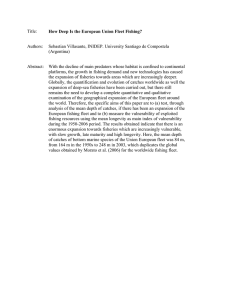
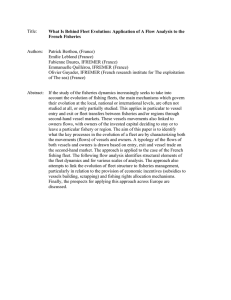
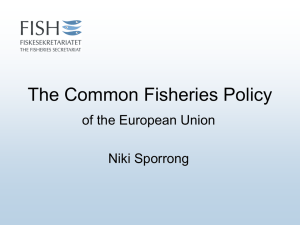
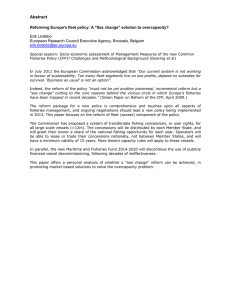
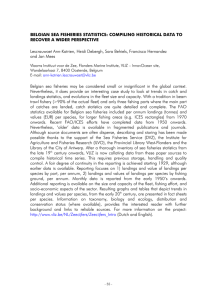
![[STORY ARCHIVES IMAGE]](http://s3.studylib.net/store/data/007416224_1-64c2a7011f134ef436c8487d1d0c1ae2-300x300.png)
